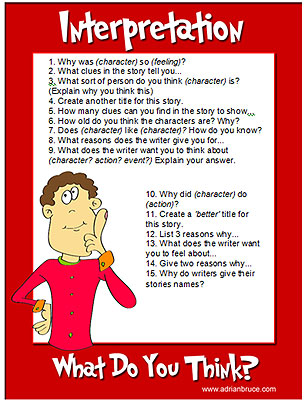
In the article, What Every Teacher Needs to Know About Comprehension, Pardo gives some excellent strategies on how to help children understand what they are reading. She begins by stating the importance of teaching children how to decode words and increase their fluency. She says with these skills, children will spend less time trying to tackle difficult vocabulary words and more time comprehending the material. The part of this article that I enjoyed so much, was her suggestion to build children's knowledge on subject materials. It is also important to discuss the concept of a schema with the children. This allows them to think about their previous knowledge. With prior knowledge about a subject, the children will have to spend less time thinking about what the text is saying, and will be able to spend more time making text to text, text to self, and text to world connections. They will gain much more from the readings if they are able to make these types of connections. It is also beneficial to discuss the book that you are reading. If you provide some type of information and background about the story, the children will be able to understand what is happening more easily. Another great suggestion that Pardo gave was to provide the children with questions about what they are reading so that they can "check-in" and be able to monitor if they are grasping the content of the text.
The second article that I read was, Kindergarteners Can do it too! Comprehension Strategies for Early Readers. In this article, Gregory and Cahill suggested many of the same ideas that Pardo did. The biggest idea in the article was the idea of discussing schemas and making connections to the literature. The teacher in this article taught reading in a creative way and her students had many creative ways to express their thoughts and ideas. They created charts, had meaningful discussions and expressed their thoughts about the stories they read. The idea that I liked in this article was teaching the children to think about the "Mind Movies" in their heads. They were able to imagine what was going on in the story and draw the pictures and ideas after the story was over.
I have never learned about schemas before but I think they are such a good way to help students with comprehension. By using prior knowledge and things students can relate to comprehension can be made into something interesting and that the students could relate to. I also read the "Kindergarteners Can do it too! Comprehension Strategies for Early Readers" and thought the "Mind Movies" were a fun and interesting teaching strategy and is something I might like to use that method in my classroom one day!
ReplyDeleteThe Mind Movies help students to use visual imagery while reading/ This is one way to connect their senses to the workings of their brain. I think that by asking students to visualize things themselves (as opposed to always showing them video clips) it promotes divergent thinking and critical thinking. Their creativity will be kicked into gear by doing this activity. I really like this strategy and will hopefully use it sometime soon! Thanks for posting, because I did not read that particular article.
ReplyDelete